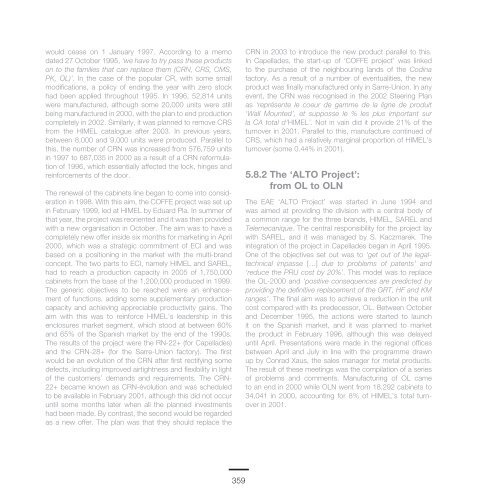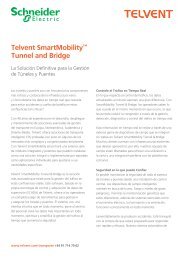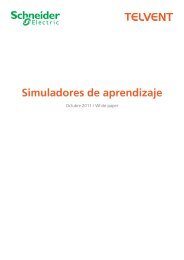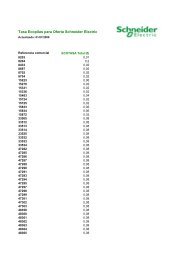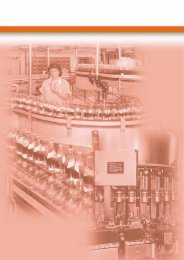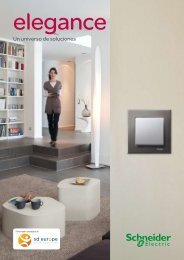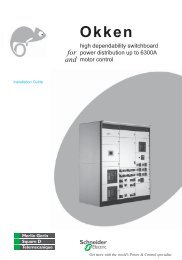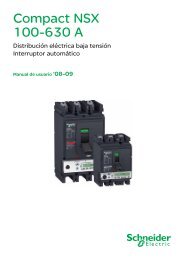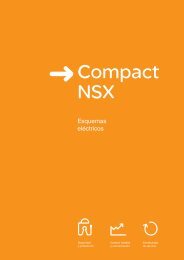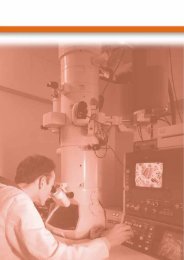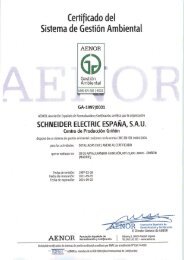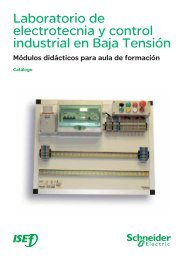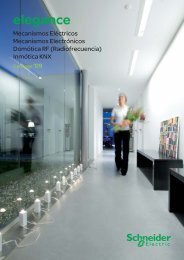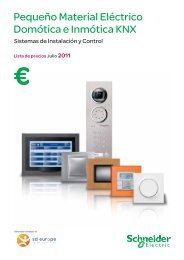Untitled - Schneider Electric
Untitled - Schneider Electric
Untitled - Schneider Electric
Create successful ePaper yourself
Turn your PDF publications into a flip-book with our unique Google optimized e-Paper software.
would cease on 1 January 1997. According to a memodated 27 October 1995, ‘we have to try pass these productson to the families that can replace them (CRN, CRS, CMS,PK, OL)’. In the case of the popular CR, with some smallmodifications, a policy of ending the year with zero stockhad been applied throughout 1995. In 1996, 52,814 unitswere manufactured, although some 20,000 units were stillbeing manufactured in 2000, with the plan to end productioncompletely in 2002. Similarly, it was planned to remove CRSfrom the HIMEL catalogue after 2003. In previous years,between 8,000 and 9,000 units were produced. Parallel tothis, the number of CRN was increased from 576,759 unitsin 1997 to 687,035 in 2000 as a result of a CRN reformulationof 1996, which essentially affected the lock, hinges andreinforcements of the door.The renewal of the cabinets line began to come into considerationin 1998. With this aim, the COFFE project was set upin February 1999, led at HIMEL by Eduard Pla. In summer ofthat year, the project was reoriented and it was then providedwith a new organisation in October. The aim was to have acompletely new offer inside six months for marketing in April2000, which was a strategic commitment of ECI and wasbased on a positioning in the market with the multi-brandconcept. The two parts to ECI, namely HIMEL and SAREL,had to reach a production capacity in 2005 of 1,750,000cabinets from the base of the 1,200,000 produced in 1999.The generic objectives to be reached were an enhancementof functions, adding some supplementary productioncapacity and achieving appreciable productivity gains. Theaim with this was to reinforce HIMEL’s leadership in thisenclosures market segment, which stood at between 60%and 65% of the Spanish market by the end of the 1990s.The results of the project were the RN-22+ (for Capellades)and the CRN-28+ (for the Sarre-Union factory). The firstwould be an evolution of the CRN after first rectifying somedefects, including improved airtightness and flexibility in lightof the customers’ demands and requirements. The CRN-22+ became known as CRN-évolution and was scheduledto be available in February 2001, although this did not occuruntil some months later when all the planned investmentshad been made. By contrast, the second would be regardedas a new offer. The plan was that they should replace theCRN in 2003 to introduce the new product parallel to this.In Capellades, the start-up of ‘COFFE project’ was linkedto the purchase of the neighbouring lands of the Codinafactory. As a result of a number of eventualities, the newproduct was finally manufactured only in Sarre-Union. In anyevent, the CRN was recognised in the 2002 Steering Planas ‘représente le coeur de gamme de la ligne de produit‘Wall Mounted’, et supposse le % les plus important surla CA total d’HIMEL’. Not in vain did it provide 21% of theturnover in 2001. Parallel to this, manufacture continued ofCRS, which had a relatively marginal proportion of HIMEL’sturnover (some 0.44% in 2001).5.8.2 The ‘ALTO Project’:from OL to OLNThe EAE ‘ALTO Project’ was started in June 1994 andwas aimed at providing the division with a central body ofa common range for the three brands, HIMEL, SAREL andTelemecanique. The central responsibility for the project laywith SAREL, and it was managed by S. Kaczmarek. Theintegration of the project in Capellades began in April 1995.One of the objectives set out was to ‘get out of the legaltechnicalimpasse […] due to problems of patents’ and‘reduce the PRU cost by 20%’. This model was to replacethe OL-2000 and ‘positive consequences are predicted byproviding the definitive replacement of the GRT, HF and KMranges’. The final aim was to achieve a reduction in the unitcost compared with its predecessor, OL. Between Octoberand December 1995, the actions were started to launchit on the Spanish market, and it was planned to marketthe product in February 1996, although this was delayeduntil April. Presentations were made in the regional officesbetween April and July in line with the programme drawnup by Conrad Xaus, the sales manager for metal products.The result of these meetings was the compilation of a seriesof problems and comments. Manufacturing of OL cameto an end in 2000 while OLN went from 18,292 cabinets to34,041 in 2000, accounting for 8% of HIMEL’s total turnoverin 2001.359


